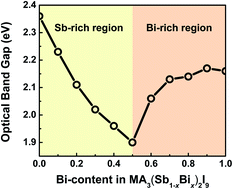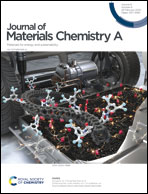Bandgap bowing in a zero-dimensional hybrid halide perovskite derivative: spin–orbit coupling versus lattice strain†
Abstract
We have considered a zero-dimensional hybrid halide perovskite derivative system, namely MA3(Sb1−xBix)2I9, to study the bandgap dependence on metal substitution. Similar to tin-lead mixed halide perovskites (MASn1−xPbxI3), the composition dependence of the optical bandgap in the MA3(Sb1−xBix)2I9 solid-state alloys showed evidence of a quadratic (bow-like) behavior where an intermediate compound containing an equimolar contribution of antimony and bismuth, MA3(Sb0.5Bi0.5)2I9 offered the narrowest bandgap of around 1.90 eV; this is markedly lower than the bandgap of the end members MA3Sb2I9 (2.36 eV) and MA3Bi2I9 (2.16 eV). In addition, we have observed the bowing in the transport gap of MA3(Sb1−xBix)2I9 that has been derived from scanning tunneling spectroscopy and density of states spectra thereof. To explain the underlying mechanism, we speculate that an antagonism between spin orbit coupling and its competing component, namely lattice strain, may have led to this bow-like nature in both optical and transport gaps. The band-diagram of heterojunctions based on MA3(Sb1−xBix)2I9 accordingly depended on the metal-composition; solar cell characteristics of the heterojunctions followed the change in the bandgap, morphology, and also the exciton binding energy.



 Please wait while we load your content...
Please wait while we load your content...